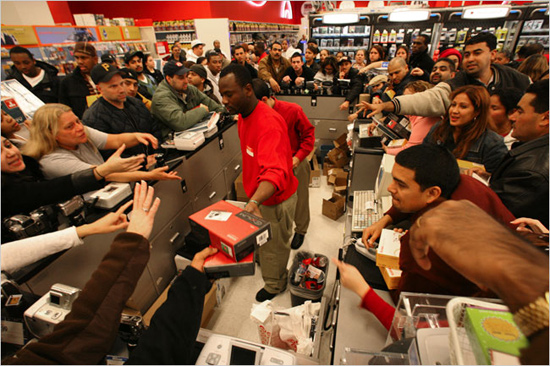
They came in droves(成群结队地), rushing into stores like this one in North Carolina at midnight - to take advantage of deep discounts(折扣) on toys and electronics.
The National Retail Federation expects nearly 140 million shoppers will shop at stores in the United States over the weekend. That's four million more than last year - the strongest showing since 2006. Industry analyst Marshal Cohen attributes(归因于) higher turnout to what he calls frugality fatigue(节俭疲劳).
"Frugal fatigue definitely has set in(上涨/到来/开始). The consumer's gotten tired of living in this no-spend cocoon(蚕茧) that they've been in for a while and they're starting to dabble(浅涉) in buying products both for themselves as well as those on the list."
And after years of declining sales, Cohen says retailers are getting smarter, offering bigger discounts, earlier in the season. "What's really going on is that retailers are trying to race for space. The pie of holiday shopping isn't going to get much bigger so that means that what they're trying to do is beat each other to the punch and retailers now have finally recognized, the stores are saying, you know, 'We are competing against online retail. We are competing against network shopping. We have to be open more often when the consumer wants to shop.'"
And shoppers are paying attention. Many say they're shopping smarter, looking for the best advertised specials(特价商品) before hitting the stores early.
But for casual shoppers, retail analysts warn the best deals won't last long. "Retailers are not heavily inventoried(存货) this year. They've been very conservative so that means that they're really not going to get a lot of extra merchandise(货物) waiting for the consumer to come in at the end. They're going to try to move as much as they can early on."
Analysts say flat screen TVs could be among the biggest sellers this year as manufacturers and retailers clear out inventories. Online sales could also see a big bump with sales forecast to top last year's numbers by 30 percent.
Despite a solid start, economists say spending remains below pre-recession(萧条之前) levels. Shoppers say they're cautious about spending too much with unemployment numbers remaining very high at 9.6 percent.

